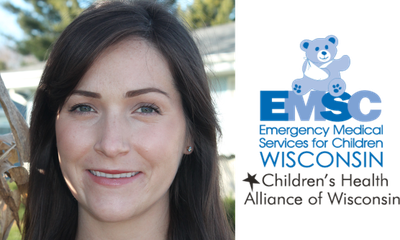State successes: Wisconsin EMSC receives $520,000 workforce development grant
- Published August 30, 2021

EMSC Pulse is launching a new series, “State successes,” to highlight the efforts of the EMSC State Partnerships, which work to improve and integrate pediatric emergency care within a state or territory’s EMS system.
This month, we sat down with Erica Kane, Program Leader of the Wisconsin EMSC State Partnership Program, to talk about an exciting grant award.
Describe a recent success within your EMSC State Partnership.
“Wisconsin EMSC was recently awarded a grant from Advancing Healthier Wisconsin Endowment to fund a Pediatric Readiness initiative. The need for this came out of the recognition that the Wisconsin EMSC Program has a lot of partners who are interested in working on pediatric readiness, but we really needed more person power in the State Partnership Program. So this new grant will provide funding for a full-time staff person to work closely with rural emergency departments (EDs) to really understand their Pediatric Readiness scores, to include gaps and opportunities for improvement, and offer support to those rural EDs in terms of QI [quality improvement] coaching, resource development and clinical expertise. This support will come both from the new EMSC Program Manager, Brittany Farrell, and the Wisconsin EMSC Medical Directors.”
How did this success come to fruition?
“The Wisconsin EMSC Medical Co-Chair (Lorin Browne, DO) was familiar with funding opportunities at the Medical College of Wisconsin and helped the program identify a funding source. We applied for this funding five times through two separate endowments (three times to a different endowment and twice to this Advancing Healthier Wisconsin Endowment) – it took perseverance to finally be approved for the funding. These endowments have multiple grant opportunities, so we researched those to find the Request for Proposal (RFP) that aligned with our idea, and we continued to refine the project concept while writing several renditions of the grant. Because we were looking to fund a full-time program manager, we only applied for opportunities that provided multiyear funding. Additionally, because so many great resources already exist on the EIIC website, we really needed to justify the benefit of additional staff support.
We also had an introductory meeting with the endowment staff to introduce them to EMSC and explain the work we do. We did this before we even applied for the funds, which was helpful to build a relationship and get our name out there. We really started at square one and spent time explaining what EMSC is and how the emergency needs of children are different. We also provided a snapshot of what pediatric emergency care in our state looks like, because a lot of people don’t realize how under-resourced critical access hospitals are and how different care can be for those treated at a rural versus tertiary hospital.
Brittany has a research background, so having that person who has that research and grant writing background was extremely helpful. Additionally, our Children’s Hospital has a foundation with grant writing staff, who helped review the grants to make sure it followed the submission rules, and they helped strengthen the narrative and the evaluation plans.”
Why is this success important/how will it potentially improve pediatric emergency care?
“The goal of this project is that each ED that Brittany works with (20 will be chosen to participate) raises its Pediatric Readiness score (percentage has not yet been determined). Brittany really brings accountability and support that many pediatric champions need to be successful. We want to go beyond just sending people to the NPRP Toolkit, and this funding will allow Brittany to provide one-on-one coaching and support to the ED. We are specifically targeting rural because those kids are so much further from tertiary care. We want to make sure the EDs are prepared to stabilize the kids that show up. Additionally, we want to show the urban hospitals that if the rural EDs are able to raise their scores, they can do it do.
We will be strategic about recruiting EDs across health systems so that we can try to spread pediatric readiness through the health system (if one rural ED becomes pediatric ready, their counterparts within the system with more resources would be more encouraged to also become pediatric ready).”
What was your biggest challenge in achieving this success, and how did you overcome it?
“One of the bigger challenges was that because we operate under a subcontract with the State Health Department, and they weren’t the applicant, we still needed to make sure we had their support. So, we were very intentional with collaboration with the department to develop work plans to make sure they were comfortable with the budget. That created an extra layer of complication.
The other thing was figuring out budget categories and allowable versus unallowable expenses. We shared drafts of both the proposal and budget throughout the application process with the project officers at the endowment to make sure we were following rules. They were happy to help with the questions rather than deny the application after so much work was put into it.”
Is there anything else you would like to add about your State Partnership’s work?
“We collaborated with the local chapters of ENA, ACEP, and AAP to help identify priority EDs and get their support for the program. It was very powerful for the project narrative to be able to name all these professional organizations that were on board with this project.”
As an EMSC Program Manager, I am so excited to have someone on board who is able to help with more of the programmatic work and really focus on hospital settings. We also just received the notice that Wisconsin received one of the Rural Supplemental grants [from HRSA]. So we would like to focus our efforts on the 20 hospitals who are part of this Endowment Grant to be the first to be recognized in our upcoming Pediatric Recognition Program (which will be developed with the new Rural Supplemental funds).”